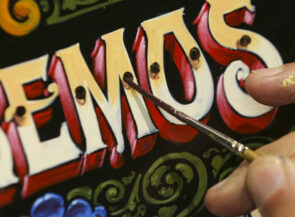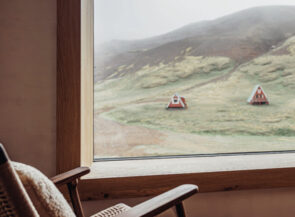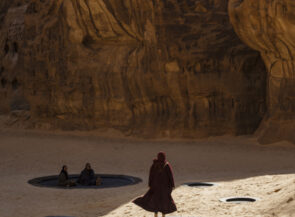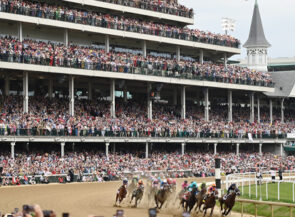More than perhaps anywhere in the U.S., Nashville has a fixed identity: Music City. It’s the home of the Ryman Auditorium, where Bill Monroe invented bluegrass, and the Grand Ole Opry, where Dolly Parton first performed at age 13. The honky-tonk bars light up Broadway every night, and last year the National Museum of African American Music opened its doors. But Nashville is much more than Music City. It’s a city of immigrants, including America’s largest Kurdish population. It’s a foodie city, where Indian and Jewish flavors earn accolades alongside traditional Southern fare. It’s a growing city, too: 23 hotels have opened in the last two years, with 12 more slated for 2022. As in every boomtown, there are fears that development might threaten Nashville’s authenticity, but the people here are working to preserve what they love while pushing things forward in the best way possible. All this is to say that you may think you know Nashville, but this city has a few tricks up her rhinestone sleeves.
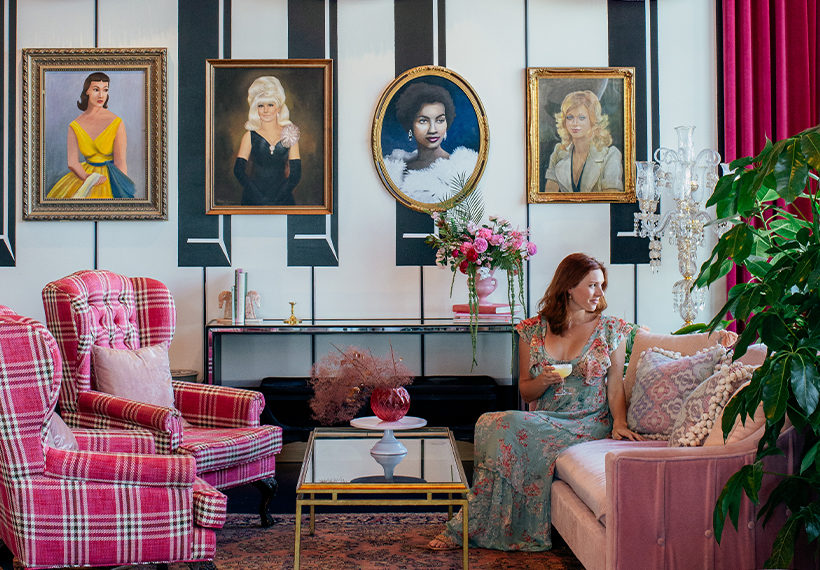
Day 1
A tabernacle, an art museum, and animatronic karaoke
Daylight peeks in through the curtains of my room on the 19th floor of The Joseph, and I rise from my downy bed like a kitten rolling out of a beanbag. I take in the view of downtown Nashville, where the Cumberland River cuts through silver skyscrapers, excited to explore. But first: coffee.
In the lobby lounge, I grab a Shakerato, the hotel’s signature citrusy caffeine jolt, with lemon-infused espresso and simple syrup, and head out into the sunshine. This neighborhood is called SoBro, for South of Broadway—a nickname that’s a punching bag for some residents, who worry the city is losing its true soul. It’s here that Nashville’s furious growth is most obvious, from multiple new hotels to the impeccable Schermerhorn Symphony Center. The architecture is yin and yang, with the neon of the honky-tonks reflected in the slick silver facades that rise above squat turn-of-the-century brick warehouses.
Ten minutes later I arrive at Pinewood Social, in the SoBro-adjacent Rolling Mill Hill district. A former garage built in 1938, it’s now the ultimate millennial hangout, with two wading pools, a salvaged retro bowling alley, and a restaurant and bar that serves single-origin coffees and avocado toast. I don’t have time for extracurriculars, but I do scatter my T-shirt with the detritus of a delicious ham-and-cheese croissant before grabbing an electric Bird scooter to cruise up Rep. John Lewis Way to Broadway.
A snatch of nostalgia and the memory of a camp talent show broadsides me as I lean my scooter by the open doorway of Tootsie’s Orchid Lounge: Garth Brooks’s “Friends in Low Places” plays on the stereo inside. One of the city’s original songwriter watering holes, Tootsie’s has ridden the development boom—I spotted a location in the airport, and there’s now one in Panama City Beach, Florida, too.
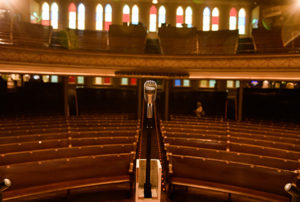
One place that could never be duplicated is the Ryman Auditorium, just a block away. I buy a ticket for a tour, which starts with a fantastic introductory video, led by a hologram of the Ryman’s former manager, Lula C. Naff. In the 1930s and ’40s, Naff turned this Gothic former tabernacle—which had also hosted everything from boxing matches and political debates to talks by luminaries such as Booker T. Washington and Helen Keller—into the nexus of country music, welcoming the Grand Ole Opry as a resident show in 1943. I walk through the auditorium, which was saved from demolition in the 1970s, between rows of pews that curve down to an amber stage. Here, Elvis displeased the crowd (don’t thrust your hips in church, young man), and June Carter met Johnny Cash. I sneak a peek at Cash’s old dressing room while a friendly old security guard holds the door.
“What’s your favorite memory of the job?” I ask.
His handlebar mustache twitches up. “Tanya Tucker once flirted with me,” he says.
From here, I’m off to the Frist Art Museum. With its “stripped classicism” exterior and Art Deco interior, this 1934 former post office is just as stunning as the pieces on display. The Frist has no permanent collection and instead rotates exhibits from other museums and private collections, most recently a Picasso show from Paris and Aboriginal art from Australia. Today, I’m moved by the brutally honest works in a Kara Walker solo exhibit called Cut to the Quick.
My treks around downtown are adding up, and it’s time to refuel. Blanco Cocina + Cantina is a mere half-mile away, and I’ve been advised by friends that the braised short rib is the protein to pick.
Inside a bright, modern space filled with plants, that lauded short rib lands on the menu in a few iterations. I opt for the tacos, with caramelized peppers and onions, cotija cheese, and sour cream. I’m not driving, so I wash it down with a fantastic Paloma Rosa, a combination of sparkling grapefruit and tequila, rimmed in a house salt mixture.
Moment of Mexico completed, I cross the neon green lawns of Centennial Park to explore the Parthenon. Yes, the Parthenon: a crazy, full-scale replica of the original in Greece, complete with a 42-foot-tall golden Athena statue inside. Built for the 1897 Tennessee Centennial Exposition, the structure lends Nashville its nickname—the Athens of the South. I admire stone columns, traverse galleries of ancient European artifacts, and visit a vibrant photography exhibition, The Looking Glass, by Lynn Goldsmith. Like the Ryman, the Parthenon was once set for demolition but was saved by determined citizens.
Happy hour approaches. Any time I’m visiting a city, I love to get the bird’s-eye vantage from a rooftop bar. Zeppelin, which opened in May atop the TownePlace Suites by Marriott, is aptly named, with walls of windows and cream-tone furnishings splashed pink by the fading day. Nothing distracts from the 270-degree view, except my refreshing gimlet, with gin, black lime cordial, chartreuse, and lime.
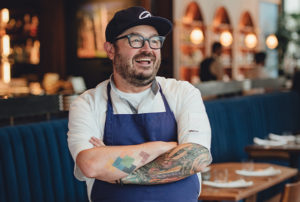
It’s an easy cab to dinner at The Continental, opened in May by chef Sean Brock, who has too many James Beard recognitions to count on one hand. He previously caught Nashville’s attention at the Capitol Grille in The Hermitage Hotel, before wowing Charleston, South Carolina, with Husk. Brock left Husk to return to Music City, and The Continental is a culmination of years he spent poring over 19th-century cookbooks. His dream was to inject historic service with fun and French Nouvelle style. I slide into a velvet banquette and take in the room, which feels like a marriage of dinner on the Titanic and an after-hours party on the set of Mad Men.
The Cure is playing on the stereo, and food carts arrive tableside, pushed by gregarious waiters. I start with a raw oyster dressed with caviar, followed by prime rib, sliced as thick as I want it for $5 an ounce. A lake of au jus shines beneath my serving, which I could slice with a spoon.
I’m stuffed but still hungry for some garish fun, and I know I’ll find it, since this city has earned the mash-up moniker “Nashvegas.” I stroll down Broadway to gawk at the neon, then take the Graduate hotel’s elevator to the Dolly Parton–themed rooftop bar White Limozeen. Twenty-somethings flirt beneath Barbie-pink umbrellas by the swimming pool and take photos in front of a giant statue of Parton’s head. One Champagne Jell-O shot later, I head downstairs to Cross-Eyed Critters, the world’s first animatronic karaoke bar. It’s like an adults-only Chuck E. Cheese, where robotic animals act as a backup band for your song of choice. Do I possess the bravery to take the stage? All I can say is what happens in Nashvegas, stays in Nashvegas.
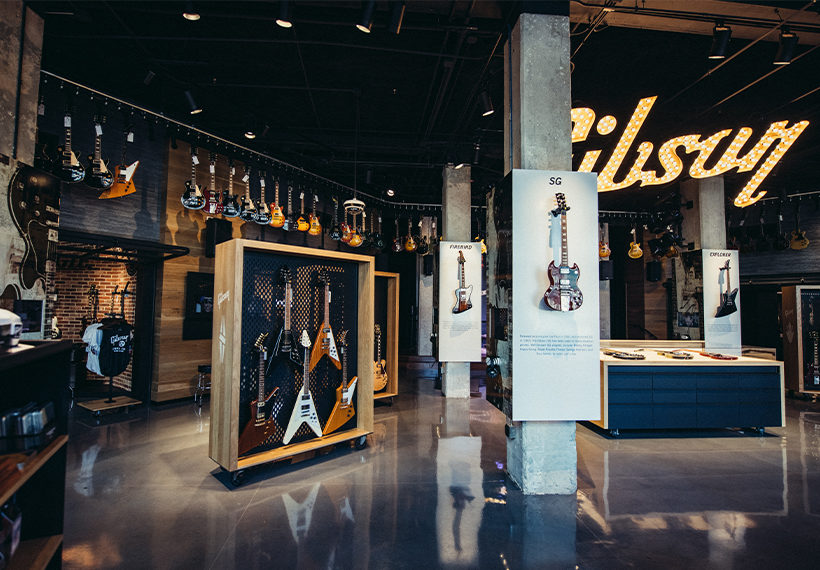
Day 2
Doughnuts, electric guitars, and marigolds
I set an alarm, but the road to hell is paved with the snooze button. I do not make it to The Joseph’s sky-high, all-glass gym, but I do arrive on time at the glass door of D’Andrews Bakery & Café. Inside the bright, minimalist space, notes of grilled sausage mingle with caramelized sugar. I scarf down both, via the D’onut (a vanilla-cream brioche) and a chicken-sausage sandwich slathered with a delicious roasted-tomato mayo.
Next I’m off to the National Museum of African American Music, a 56,000-square-foot interactive institution that opened downtown last January after nearly two decades of planning. I meet up with Tuwisha Rogers-Simpson, VP of brand and partnerships at the museum, for a tour.
“Our galleries can educate chronologically,” she tells me, “but it’s music. Allow yourself to be pulled by what interests you.”
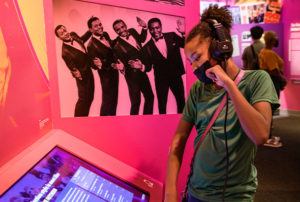
We begin at Wade in the Water, an exhibit about the impact of religion and slavery on music, where we join a virtual gospel choir. I loosen up with each verse, although Rogers-Simpson’s got the real pipes. Then we trek to New Orleans (where I live) for A Love Supreme, which is dedicated to Congo Square and jazz. “Love Supreme is my favorite,” Rogers-Simpson says, pointing out Ella Fitzgerald’s Grammy and tiny coat.
Throughout the museum, I stop at listening stations to scan my wristband, and the tracks I love are emailed to me. The last gallery proves the most emotional. I’ve watched Prince’s 2007 Super Bowl performance more than 20 times, but now I can see it from fresh angles on floor-to-ceiling 3-D screens. Raindrops pour down his face and guitar; hearing him sing “Purple Rain” gives me goosebumps. Rogers-Simpson wipes away a tear. “I see that six times a day, and it never fails to get me,” she says, laughing.
As I leave, I can’t help but think about my own relationship with music. These days I treasure my Ella Fitzgerald vinyl, but as a kid in the ’80s and ’90s it was all about my Guns N’ Roses and Mötley Crüe cassettes. Unsurprisingly, my heart skips a beat when I enter the Gibson Garage. More than 200 gorgeous, shiny guitars, ink black to cherry red, Les Paul to Flying V, soar above on a ceiling carousel system. This flagship store/museum/ showroom opened at historic Cummins Station in June, when the brand moved its world headquarters to Nashville. I could buy an axe off the shelf, custom-build my own Les Paul in the Murphy Lab, or take an augmented reality lesson. Instead, I spend my time staring at an exact replica of Slash’s 1966 EDS-1275 Doubleneck guitar. Be still my tiny 1987 heart. “It’s $12,000,” I whisper to my American Express, “and we don’t even play guitar.”
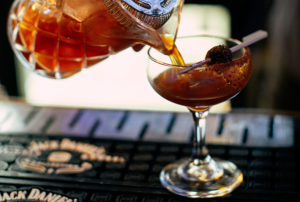
Be still my rumbling stomach, too. I meet up with my longtime friend Matt Bolus, who also happens to be the executive chef of The 404 Kitchen and Gertie’s Whiskey Bar. Pro tip: Always ask a local chef where to snag lunch, but be prepared to get very full.
Normally, Matt would take me to the full-scale experience of Prince’s Hot Chicken, out on Nolensville Pike, but the bird is just as crispy, fiery and delicious at the stall inside Assembly Food Hall, just a few blocks from the Gibson Garage.
There are more than a dozen places to nosh and sip at this modern, multi-story emporium, and the long line at Prince’s moves rapidly. I am instructed to order the Mild, being a newbie. Thank God for good advice. The crunchy batter is still an eye-opener, with great seasoning, mellowed by my additions of cold potato salad and gooey mac and cheese.
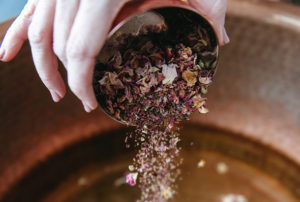
It’s time to lie down—and treat myself to a facial at The Joseph’s spa, Rose. The attendant looks like a porcelain doll, and I wonder if she can smell the gravy leaking from my pores. My treatment utilizes a Biologique Recherche Remodeling Face Machine, and I’m a bit nervous about “electric currents stimulating my circulation,” but after barely noticeable zaps move over one half of my face, she hands me a mirror. One side does look less puffy, more youthful. She zaps my other half and, after a quick shower, I take my revitalized visage back out on the town.
I meet back up with Matt at his stomping ground, Gertie’s Whiskey Bar—a dark space with a masculine vibe and a library ladder for accessing the 600 or so bottles on the backlit wall. I order his Nashville Hot Manhattan: Sazerac 6-year rye, Carpano Antica vermouth, Cynar, Aleppo chili honey, and a firewater tincture, offered mild, medium, or Nashville hot. When in the Athens of the South, as they say… After just one drink both my head and my lips are buzzing. I’m OK with that.
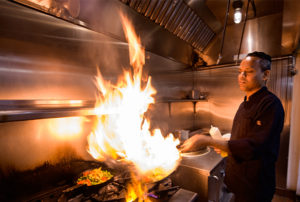
My spicy education continues a 10-minute walk away at Chauhan Ale & Masala House. Punjab-born chef Maneet Chauhan opened her restaurant in 2014, and her ensuing culinary rise includes being the first Indian woman to compete on Iron Chef, cooking at the White House, and being a judge on Chopped. Her dining room smells of saffron and fenugreek, marigolds add flashes of vibrant ocher to the exposed brick walls, and ’90s hip-hop sets the vibe. I dig into tandoori chicken poutine, a playful take on the Canadian favorite, and then a fragrant korma with cashews and tender lamb. When Chauhan stops by my table, I can’t help but ask, “Why Nashville?”
“Nashville was an exciting challenge,” she says warmly. “We were among the first to bring ethnic flavors to Nashville, and I also loved the commonalities between the American South and India— both cultures show love through food, and both love well-placed spice.”
At the end of a music-filled day, I’m dying to see a show, so I head down 12th Avenue South to The Station Inn, arguably the best place to hear bluegrass and Americana in town. The setting, with its low ceiling, folding chairs, and burned-out Christmas lights, feels more church basement than premier music venue. But as soon as the musician onstage starts sawing away at his fiddle, I feel transported. I make my way to the bar to order a Budweiser, plucked from a bumper-sticker-covered fridge, and then find a folding chair between two men in flannel shirts, where I proceed to have a knee-slappin’ good time. I swear, before I depart for bed, that I see a spark fly from that fiddler’s fingers.
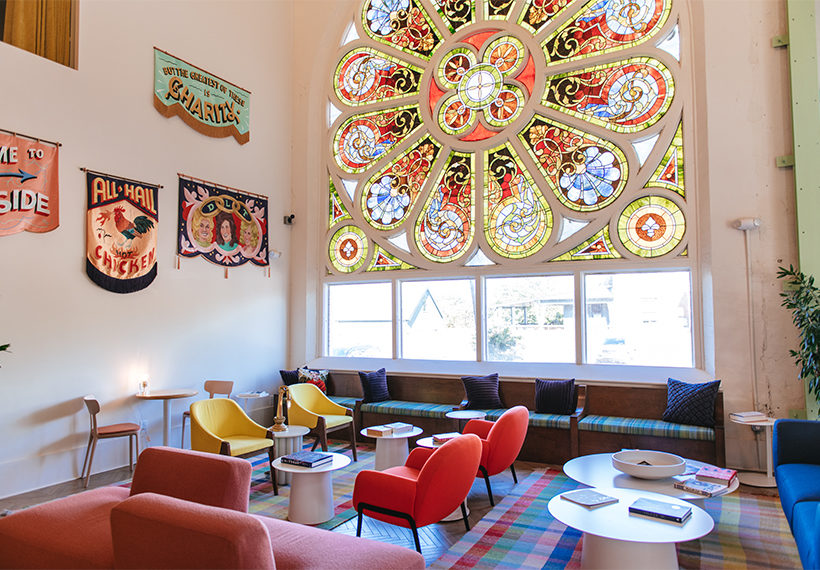
Day 3
Historic churches, wild spaces, and beautiful songbirds
For my final day, I transfer to The Russell, a hotel in East Nashville, across the Cumberland River. Called the city’s “Coolest Neighborhood” by Vogue way back in 2016, East Nashville has long drawn artists, young couples, and open minds—which means it’s packed with craft breweries, music venues, and independent shops.
The Russell is a prime example of preservation within progress. It’s a 118-year-old church that has been reimagined as a hotel—sans front desk. I punch a keypad to enter my room, which is painted in swaths of plum. The headboard is refashioned from an antique pew, and the sheets are so soft I fire up my laptop and buy a set before meeting hotel founder Micah Lacher in the lobby. We sit beneath a stunning stained-glass window and sip lattes while talking about the hotel’s mission to help those experiencing homelessness in Nashville. A percentage of the room rate for every guest who stays at The Russell or its sister property, The Gallatin, goes to those in need, with a typical weekend stay covering roughly 16 nights of shelter, 100 free showers, or 30 meals.
“I grew up as the recipient of charity, and I’ve never forgotten it,” says Lacher, the president of Anchor Investments, a real-estate company. “I loved the concept of business as a mission, and I loved that we could not only support East Nashville’s original community through this growth, but also save historic buildings.”
It’s more than 2 miles to Monell’s for breakfast, so I opt for an Uber, which sends me eight minutes west, to a stunning, 1905, brick mansion in Germantown.
Breakfast begins at 8 a.m., seven days a week here, and I break apart a most-fluffy, buttery biscuit, served aside thick-sliced country ham, their famous fried apples, crunchy hashbrowns and an overkill order of scrambled eggs.
Although trying on clothes after that breakfast may not be smart, I can’t help but do a little shopping in the gritty Fatherland District. Graffiti murals decorate a collection of tiny interconnected shops—some only 200 square feet. I buy my mom note cards at Gift Horse, and inside a shop called Ellie Monster I fall prey to a vintage chambray shirt with two green dinosaurs newly chain-stitched on the collar.
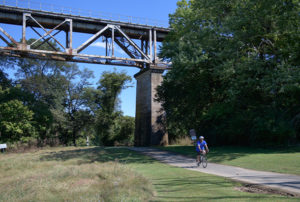
After dropping my finds at the hotel, I decide I could use some exercise and fresh air. Thankfully, the Nashville metro area has more than 15,000 acres of parkland and green space. At the end of a short Uber ride, I find myself standing on a wooden footbridge, surrounded by hickory, hackberry, and elm trees at the Shelby Bottoms Greenway—a 960-acre park along the Cumberland River. Over the next hour, I burn off the pasta pancakes hiking beneath willow trees by a quiet pond and on rustic trails through the forest, listening to frogs chirp and breathing the crisp Tennessee air.
Another Uber brings me to South Nashville’s Little Kurdistan, a neighborhood that’s home to thousands of Kurdish immigrants and Kurdish Americans, who began arriving here in the 1970s. I open the door at Edessa more curious than hungry, but when a wave of turmeric hits me I’m suddenly ready to eat. A friendly waiter helps me decide what to order. I start with gozleme, a flaky pastry with molten cheese and spiced spinach, and then dig into a plate of lamb—finely shaved, earthy, and robust. The waiter brings me a splash of ayran to try, and I immediately fall for the thin, sour, ice-cold yogurt drink.
Eager to do a bit more shopping, I check out 12 South, a vibrant street of postcard-perfect bungalows and tidy shops with pastel awnings halfway between Little Kurdistan and downtown. I peruse cowboy boots and flowy skirts at Emerson Grace and pop in for an espresso at Frothy Monkey, where students from nearby Vanderbilt University sit on the porch of an old Craftsman house. Imogene + Willie is one of my favorite online shops, so I head inside the flagship—a cool converted 1950s gas station where denim lines the walls and engraved pocket knives, bandannas, and ultra-soft, hand-printed T-shirts tempt from a table. I leave with an African ginger and mahogany candle, the brand’s signature scent.
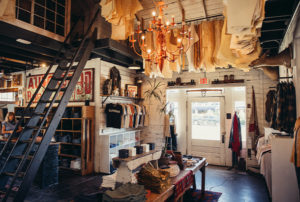
Somehow it’s time for my dinner res at Etc. in Green Hills, an affluent neighborhood just a few minutes away. Trailblazing Nashville chef Deb Paquette opened this global-fusion spot back in 2016, and it’s been drawing crowds ever since. My bread is complemented by a duo of butters—Indian mustard-spiced and apple pie—and my server expertly pairs a crisp French chardonnay with furikake fried green tomatoes topped with cashew wasabi and miso tofu aioli.
It’s time to end my trip on a high note, at The Bluebird Café, hallowed ground for songwriters all around the world. I first learned of it in the 1993 River Phoenix and Samantha Mathis movie The Thing Called Love (“Look out, Music City! ’Cause here I am, and I ain’t never leaving!”), but it’s been around since 1982, welcoming aspiring musicians and established artists alike.
I arrive just as the 9 p.m. set is starting and am led silently to my chair. The 90-person room is full, dark, and hushed, all eyes watching young Brooks Huntley make his Bluebird debut. His voice is clear and full, with a magnetic, lonesome drawl. A 14-year-old Taylor Swift was discovered here back in 2004, and she showed up unannounced to play a set in 2018. That’s how it is here: revered, but as open to newcomers as it is to established artists.
Looking around the room at the smiling crowd, I realize the same could be said of Nashville. It’s a place that eagerly embraces the new but holds on tight to its history. And isn’t that how it should be?
I take a sip of my whiskey and raise my glass as the crowd breaks into applause. To Nashville.
From Blue Skies to Bluegrass: United serves Nashville directly from several hub airports to provide you with a harmonious journey to Music City.

